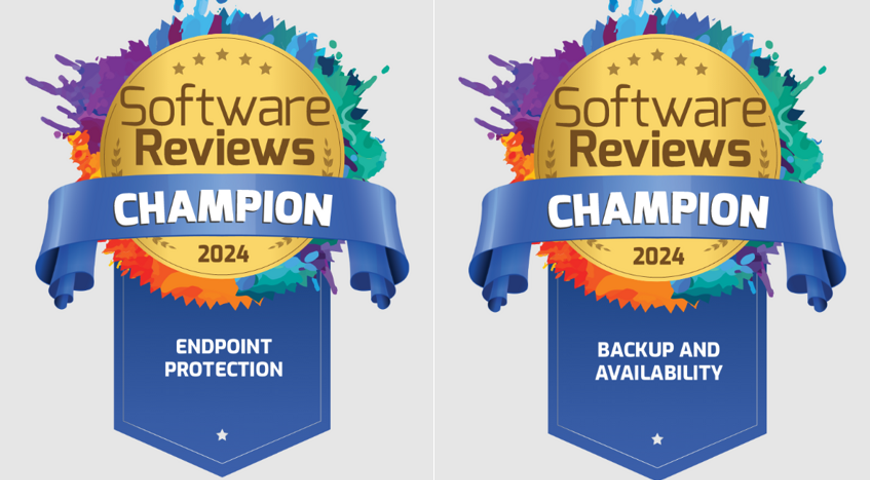
In the face of growing digital uncertainty, more and more businesses are turning to hybrid cloud storage for data management and protection. This approach seamlessly blends the flexibility of public clouds with the security of private environments, offering a dynamic solution to the challenge of balancing accessibility and protection. This article explores the benefits, implementation best practices, and challenges of hybrid cloud storage, providing insights to unlock its transformative potential.
What this article will cover:
- What is hybrid cloud storage?
- Advantages of hybrid cloud storage
- Components of hybrid cloud storage
- Implementing hybrid cloud storage
- Data management in hybrid cloud storage
- Challenges and considerations
- Hybrid cloud storage: Best practices
- Real-world use cases for hybrid cloud storage
- Future trends in hybrid cloud storage
What is hybrid cloud storage?
Hybrid cloud storage is a versatile data management strategy that combines on-premises and cloud-based infrastructure. Think of it as a tailored solution, where your sensitive, critical data resides securely on your own servers, enjoying the comforts of a private sanctuary, while your more flexible, dynamic data is relegated to the public cloud. This approach helps organizations optimize their storage resources, scaling data capacities on demand to meet varying needs.
The real beauty of hybrid cloud storage lies in its adaptability. As you navigate the space between on-premises and the cloud, you can strategically position your data based on performance, cost, and security considerations. This allows you to straddle both worlds, seamlessly enjoying the benefits of each through a unified platform. Ultimately, this approach provides both a cohesive storage solution and an effective balance between flexibility and security.
Advantages of hybrid cloud storage
By blending on-premises reliability with the dynamic prowess of the public cloud, this hybrid solution brings a lot of advantages.
Scalability
Hybrid cloud storage excels in scalability, offering organizations the ability to adjust their storage resources in real-time. Imagine the agility to accommodate fluctuating workloads effortlessly, ensuring optimal performance without overburdening your infrastructure.
Flexibility
Flexibility isn’t just about resource management. The hybrid cloud option also allows businesses to strategically position their critical and sensitive data on on-premises servers, maintaining tight control and security. Meanwhile, less sensitive or more dynamic data can flow into the public cloud to take advantage of the accessibility and adaptability it provides.
Cost-effectiveness
The ability to scale resources on demand means organizations pay for what they use, avoiding unnecessary expenses during periods of lower activity. It's a smart financial move, ensuring that storage costs align with actual requirements.
Security
By housing critical data on-premises, SMBs and enterprises can maintain a high level of control and compliance. At the same time, the public cloud aspect adheres to stringent security protocols, creating a robust defense against potential threats.
In essence, hybrid cloud storage blends many of the best features available into a single data protection option. It's the strategic ‘sweet spot’ where IT administrators and end users can enjoy both the reliability of on-premises solutions and the limitless possibilities of the cloud.
Components of hybrid cloud storage solutions
A hybrid cloud storage solution is a finely-tuned machine, with each component working together to support a robust data management strategy. At the heart of this machine are three key parts: the private cloud, the public cloud, and on-premises infrastructure.
Private cloud
This component is the secure haven within the hybrid solution. Here, organizations host and manage their critical and sensitive data on dedicated servers. This controlled environment provides the highest level of security, compliance, and governance over the stored information.
Public cloud
In this component, less sensitive or more dynamic data finds its home. Public cloud services including Microsoft Azure, Amazon Web Services (AWS), and Google Cloud Platform (GCP) enable organizations to scale their storage resources on demand. The accessibility and adaptability of the public cloud make it an ideal location for data that requires frequent changes, rapid scaling, or access for collaboration.
On-premises infrastructure
Physical servers and storage devices within an organization's own data center make up this essential component of the hybrid cloud ‘machine’. Here, organizations maintain control over their data, ensuring proximity for low-latency access and compliance with specific regulatory requirements. On-premises infrastructure acts as the lynchpin of the complete solution, providing a stable and reliable foundation for critical applications and data.
The beauty of a hybrid cloud storage solution lies in the seamless meshing of these components. Data moves between the private and public clouds, orchestrated by a unified management platform. This ensures that organizations can leverage the security and control of on-premises solutions while embracing the flexibility and scalability offered by the cloud.
Implementing hybrid cloud storage
The decision to implement hybrid cloud storage should be carried out with a methodical approach. The following section will guide you through the key steps, helping your business achieve a harmonious integration of on-premises infrastructure with private and public cloud components:
Assess requirements
Begin with a thorough assessment of organizational requirements. Understand the nature of your data — what needs the security of on-premises storage, and what can benefit from the scalability of the public cloud. Consider performance, compliance, and data access patterns to inform your hybrid strategy.
Select providers
Choose the right cloud service providers to complement your hybrid setup. This decision hinges on factors such as service offerings, reliability, and compatibility with your organizational needs. Industry giants like AWS, Azure, and Google Cloud often play pivotal roles in the public cloud aspect, while private cloud solutions need careful consideration based on security and customization requirements.
Integrate on-premises infrastructure
The integration of on-premises infrastructure is the cornerstone of the overall implementation. Ensure seamless connectivity between your existing data center and the chosen cloud services. This involves configuring networks, establishing secure communication channels, and possibly implementing hybrid cloud management platforms. The goal is to create a unified environment where data can flow freely while maintaining the necessary controls and security.
Plan data migration
Develop data migration strategies that consider factors like data volume, transfer speed, and potential downtime. Whether it's a phased migration or a simultaneous shift, the strategy should minimize disruption and ensure data consistency.
Enact security measures
Bolster your hybrid setup with robust security measures, including encryption protocols, access controls, and identity management. Align security policies across on-premises and cloud environments to maintain a cohesive defense against potential threats.
Monitor and optimize
Implement tools for real-time performance monitoring, cost analysis, and resource utilization. This ongoing vigilance ensures that the hybrid cloud storage environment evolves in lockstep with organizational needs, making adjustments as data dynamics and requirements shift.
Data management in hybrid cloud storage
Data management in a hybrid cloud solution is all about striking the right balance between on-premises and cloud environments. The following is a breakdown of the essential aspects involved:
Data placement and classification
Start by strategically placing data based on its sensitivity, access frequency, and performance requirements. Critical or sensitive data may reside on on-premises servers, while less sensitive or more dynamic data can take advantage of the scalability offered by the public cloud. Implement a robust classification system to guide current and future data placement decisions.
Unified data management platform
Consider adopting a unified data management platform that seamlessly integrates on-premises and cloud environments. This platform streamlines processes and enhances visibility by orchestrating data movements, ensuring consistency, and providing a single pane of glass for monitoring and management.
Data movement and synchronization
Enable fluid data replication and synchronization between on-premises and cloud storage. Implement efficient data transfer protocols to minimize latency and downtime during migrations. Automation tools can facilitate scheduled data synchronization, ensuring that information remains current and consistent across both environments.
Security and compliance
Security and data governance take center stage in the data management composition. Implement robust encryption protocols for data at rest and in transit. Ensure that access controls and identity management policies are consistently applied across on-premises and cloud storage. Regularly audit and update security measures to stay compliant with industry regulations and organizational policies.
Backup and disaster recovery
Craft a comprehensive backup and disaster recovery strategy that spans both on-premises and cloud environments. Regularly backup critical data to prevent loss and enable swift recovery in the event of a disaster. Leverage the redundancy and geographic distribution offered by the hybrid setup to enhance data resilience.
Cost optimization
Keep a keen eye on costs associated with data storage and management. Leverage cloud services' pay-as-you-go model to optimize expenses based on actual usage. Implement data lifecycle management policies to automatically move less frequently accessed data to more cost-effective storage tiers, balancing performance and expenditure.
Monitoring and analytics
Implement robust monitoring and analytics tools to gain insights into data usage patterns, performance metrics, and potential bottlenecks. Proactively address issues, optimize resource allocation, and ensure that the hybrid setup evolves in alignment with changing data dynamics and organizational needs.
Collaborative tools and version control
Foster collaboration by implementing tools that facilitate seamless access to data across your hybrid cloud environment. Ensure version control mechanisms are in place to manage changes efficiently, especially in collaborative work scenarios. This ensures that teams can work cohesively regardless of where the data resides.
Challenges and considerations of hybrid cloud storage
Implementing hybrid cloud storage brings a blend of benefits, but it's not without its challenges and considerations. Here's a breakdown of key aspects that organizations often need to navigate:
Network connectivity and latency
The hybrid setup relies heavily on seamless network connectivity between on-premises infrastructure and cloud services. Challenges may arise in managing latency, especially for applications requiring real-time data access. Ensuring a robust and high-bandwidth network is essential to maintain optimal performance.
Data transfer and bandwidth
Efficient data transfer between on-premises and the cloud is crucial. Large-scale migrations or frequent data synchronization can strain bandwidth, leading to potential bottlenecks. Organizations must carefully plan data transfer strategies, optimizing bandwidth usage to minimize disruptions and avoid performance degradation.
Data security and compliance
Security considerations become multifaceted in a hybrid environment. Ensuring consistent security measures across on-premises and cloud storage is critical. Additionally, navigating compliance requirements, which might vary across different regions and industries, adds complexity. Robust encryption, access controls, and regular compliance audits are essential components of a comprehensive strategy.
Integration complexity
Integrating on-premises infrastructure with diverse cloud services can be complex. Differences in APIs, storage architectures, and data formats may require custom integration solutions. Organizations must invest time in designing a seamless integration strategy that accounts for these complexities to ensure smooth data flow.
Data governance and control
Maintaining data governance and control across hybrid environments poses challenges. Organizations need to establish clear policies for data access, usage, and retention that are uniformly applied. Striking the right balance between accessibility and control is crucial to prevent data mishandling or unauthorized access.
Cost management
While the cloud offers flexibility, it can also introduce unpredictable costs. Understanding and managing the cost implications of data storage, data transfer, and cloud services is essential. Implementing effective cost management strategies, such as optimizing resource usage and leveraging cost-effective storage options, helps prevent budget overruns.
Data residency and sovereignty
Different regions have varying data residency and sovereignty requirements. Navigating these complexities, especially when dealing with sensitive or regulated data, requires careful planning. Understanding the legal and regulatory landscape in each region is essential to ensure compliance and prevent legal complications.
Skills and training
Operating in a hybrid environment may demand new skills and expertise from the IT team. Training staff to effectively manage and troubleshoot issues specific to the hybrid setup is crucial. Ensuring that the team is well-equipped to handle both on-premises and cloud technologies enhances the overall efficiency of the hybrid storage solution.
Data lifecycle management
Developing effective data lifecycle management policies is essential. Ensuring that data is appropriately moved between storage tiers based on access frequency and relevance helps optimize costs and storage performance. A well-defined strategy prevents unnecessary storage expenses for maintaining data that is infrequently accessed.
Navigating these challenges and considerations requires a strategic and holistic approach. By addressing these points, SMBs and enterprises can unlock the benefits of hybrid cloud storage while mitigating potential pitfalls.
Best practices in hybrid cloud storage
Embracing best practices in hybrid cloud storage is crucial for organizations seeking to maximize the advantages of both on-premises and cloud environments. The following guidelines should be considered:
Encryption and access control
- Implement robust encryption protocols for data at rest and in transit to safeguard sensitive information.
- Enforce strict access controls, ensuring that only authorized personnel can access and modify critical data.
- Leverage identity and access management (IAM) solutions to manage user permissions consistently across on-premises and cloud storage.
Performance monitoring and optimization
- Employ comprehensive performance monitoring tools to gain real-time insights into data access patterns, latency, and resource utilization.
- Regularly analyze performance metrics to identify bottlenecks and optimize storage resources accordingly.
- Utilize automation for dynamic resource allocation, ensuring optimal performance during varying workloads.
Disaster recovery planning
- Develop a robust disaster recovery plan that spans both on-premises and cloud environments.
- Regularly test disaster recovery procedures to validate their effectiveness and identify potential improvements.
- Leverage the geographical redundancy of hybrid setups to enhance data resilience and minimize the impact of localized disasters.
Data lifecycle management
- Implement data lifecycle management policies to automatically move data between storage tiers based on access frequency.
- Regularly review and update data lifecycle policies to align with changing business requirements and optimize storage costs.
Unified data management platform
- Adopt a unified data management platform that provides a single pane of glass for monitoring, management, and orchestration of data across hybrid environments.
- Ensure seamless integration with on-premises infrastructure and various cloud services, streamlining data movements and minimizing complexity.
Regular security audits
- Conduct regular security audits to identify vulnerabilities and ensure compliance with industry regulations.
- Stay informed about emerging security threats and update security measures accordingly.
- Engage in penetration testing to proactively identify and address potential weaknesses in the hybrid storage infrastructure.
Cost optimization strategies
- Implement cost optimization strategies, such as utilizing cloud storage tiers based on data access patterns and leveraging reserved instances for predictable workloads.
- Regularly review and optimize resource allocation to align with actual usage and prevent unnecessary expenses.
Training and skill development
- Invest in training programs to ensure that the IT team possesses the necessary skills to manage both on-premises and cloud technologies.
- Stay updated on industry best practices and emerging technologies through continuous learning and skill development initiatives.
Collaborative tools and documentation
- Foster collaboration between on-premises and cloud teams by implementing collaborative tools and clear documentation.
- Ensure that processes, configurations, and best practices are well-documented to facilitate seamless collaboration and knowledge transfer.
Regular testing and validation
- Conduct regular testing of data migration, synchronization, and disaster recovery procedures to validate their effectiveness.
- Perform performance testing to identify potential scalability issues and optimize the hybrid storage environment accordingly.
By incorporating these best practices into your hybrid cloud storage strategy, your organization can better navigate the complexities of data management and security, ensuring resilience in the face of unforeseen challenges.
Real-world use cases of hybrid backup
Healthcare: Electronic Health Records (EHR) management
In the healthcare sector, where data security and accessibility can literally mean the difference between life or death, a hybrid cloud storage solution can be instrumental in managing Electronic Health Records (EHR). Critical patient information requiring high security standards can be stored on on-premises servers, ensuring compliance with stringent regulations such as HIPAA. Simultaneously, less sensitive data, such as research datasets or non-sensitive administrative records, can be stored in the public cloud, leveraging its scalability for efficient access and collaboration.
Financial services: Transactional data processing and analysis
Massive volumes of transactional data must be processed and analyzed in real-time in the finance sector, and this is where the hybrid cloud storage model can truly shine. High-frequency trading systems and real-time analytics applications can benefit from the low-latency access provided by on-premises infrastructure, ensuring rapid response times. At the same time, historical financial data, archival records, and analytical workloads can leverage the scalability and cost-effectiveness of the public cloud.
Ecommerce: Scalable product catalog and customer data management
In the fast-paced world of ecommerce, where fluctuating demand and rapid scalability are the norm, a hybrid cloud storage solution can optimize operations. The core product catalog, customer account information, and high-transaction databases can reside on on-premises servers to ensure quick and reliable access. During peak times, such as holiday seasons or promotional events, the public cloud can be seamlessly integrated to scale resources, accommodating increases in traffic and demand. This hybrid approach allows ecommerce businesses to maintain control over critical operations while effortlessly scaling resources to meet dynamic market demands, ensuring a seamless shopping experience for customers.
Future trends in hybrid cloud storage
As technology continues to evolve, several future trends are expected to shape the landscape of hybrid cloud storage, offering new possibilities and addressing emerging challenges. Here are some key trends to watch for in the future:
A shift toward edge computing
The integration of edge computing with hybrid cloud storage is poised to become a significant trend. As edge computing brings processing closer to the data source, hybrid architectures will likely evolve to seamlessly manage and store data generated at the edge. This approach ensures low-latency access and more efficient data processing for applications requiring real-time responses.
Expect more integration of AI and machine learning
The infusion of artificial intelligence (AI) and machine learning (ML) into hybrid cloud storage is expected to enhance data management capabilities. AI-driven analytics will play a crucial role in optimizing data placement, automating data lifecycle management, and predicting storage needs based on usage patterns.
Multi-cloud strategies will continue to grow
Organizations are increasingly adopting multi-cloud strategies, leveraging services from multiple cloud providers. The future of hybrid cloud storage may see enhanced interoperability and management tools that facilitate seamless integration across different cloud environments. This trend aims to provide organizations with greater flexibility and optimize costs across diverse cloud platforms.
New, enhanced security measures will emerge
With the growing importance of data security, future trends in hybrid cloud storage will likely include the adoption of more advanced encryption techniques, secure key management, and increased focus on zero-trust security models. As cyber threats evolve, hybrid architectures will need to implement robust security measures to protect sensitive data both on-premises and in the cloud.
What about the impact of quantum computing?
As quantum computing advances, hybrid cloud storage solutions may need to adapt to the unique challenges and opportunities presented by quantum technologies. Quantum-safe encryption, quantum-resistant algorithms, and strategies for managing quantum-generated data could become essential considerations in future hybrid architectures.
These trends reflect the evolving nature of hybrid cloud storage, driven by the ongoing need for flexibility, security, and efficiency in managing diverse and dynamic datasets. As organizations continue to navigate the complexities of modern IT landscapes, staying abreast of these trends will be crucial for making informed decisions about hybrid cloud storage strategies.
Let’s sum it all up
Through exploration of hybrid cloud storage, we’ve revealed a landscape characterized by adaptability and innovation, strategically crafted to address the ever-evolving needs of contemporary organizations. As Scott Sinclair, Senior Analyst at Enterprise Strategy Group, puts it, "Hybrid cloud storage isn't just a technology; it's a business strategy for the future."
The blending of on-premises infrastructure with the dynamic capabilities of the cloud serves as a strategic linchpin for businesses navigating the complexities of data management. As this transformative paradigm continues to shape the way organizations orchestrate and leverage their data, it underscores not only a technological evolution but a fundamental shift in the way businesses prepare for the challenges and opportunities that lie ahead.
About Acronis
A Swiss company founded in Singapore in 2003, Acronis has 15 offices worldwide and employees in 50+ countries. Acronis Cyber Protect Cloud is available in 26 languages in 150 countries and is used by over 20,000 service providers to protect over 750,000 businesses.




